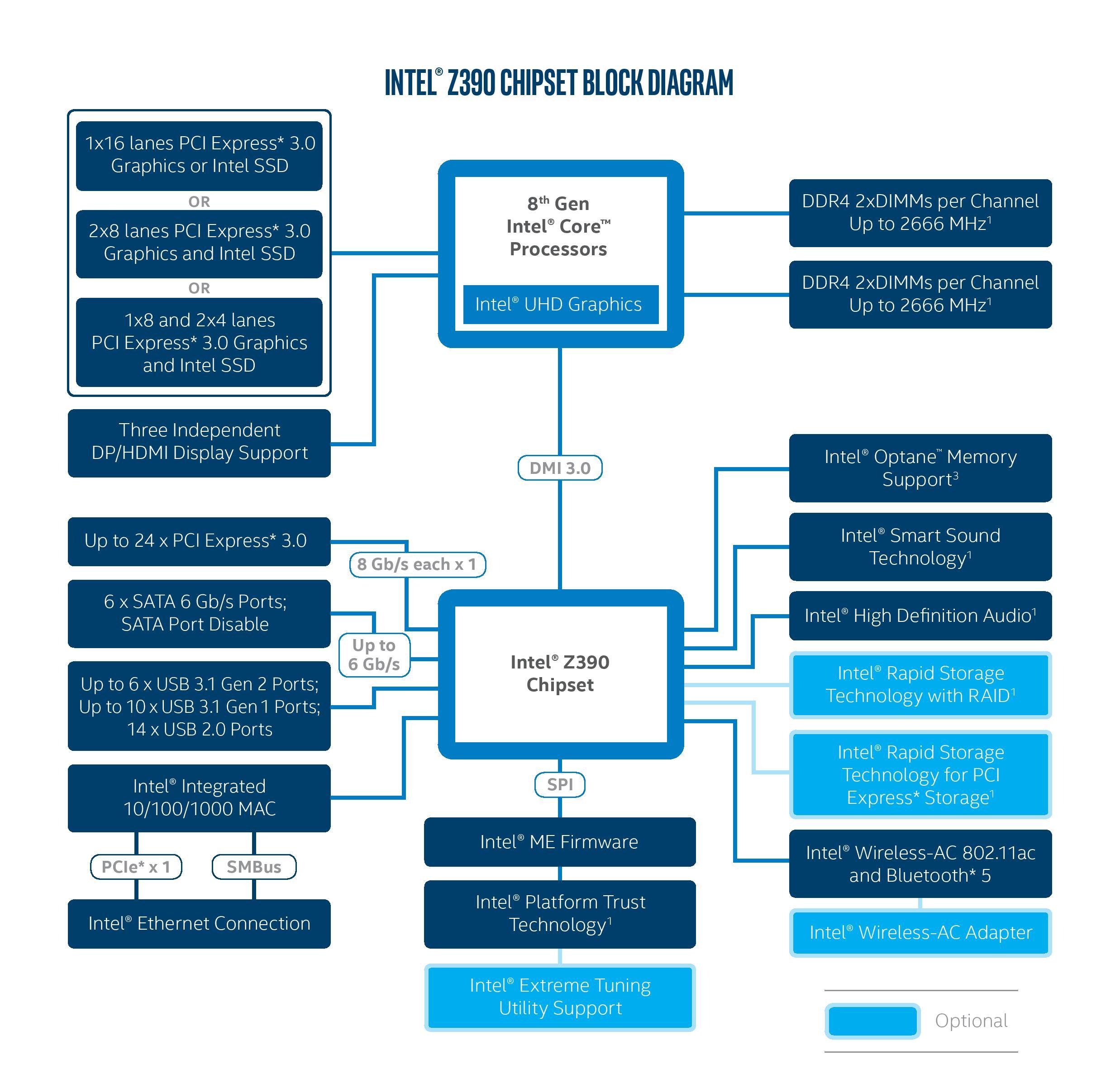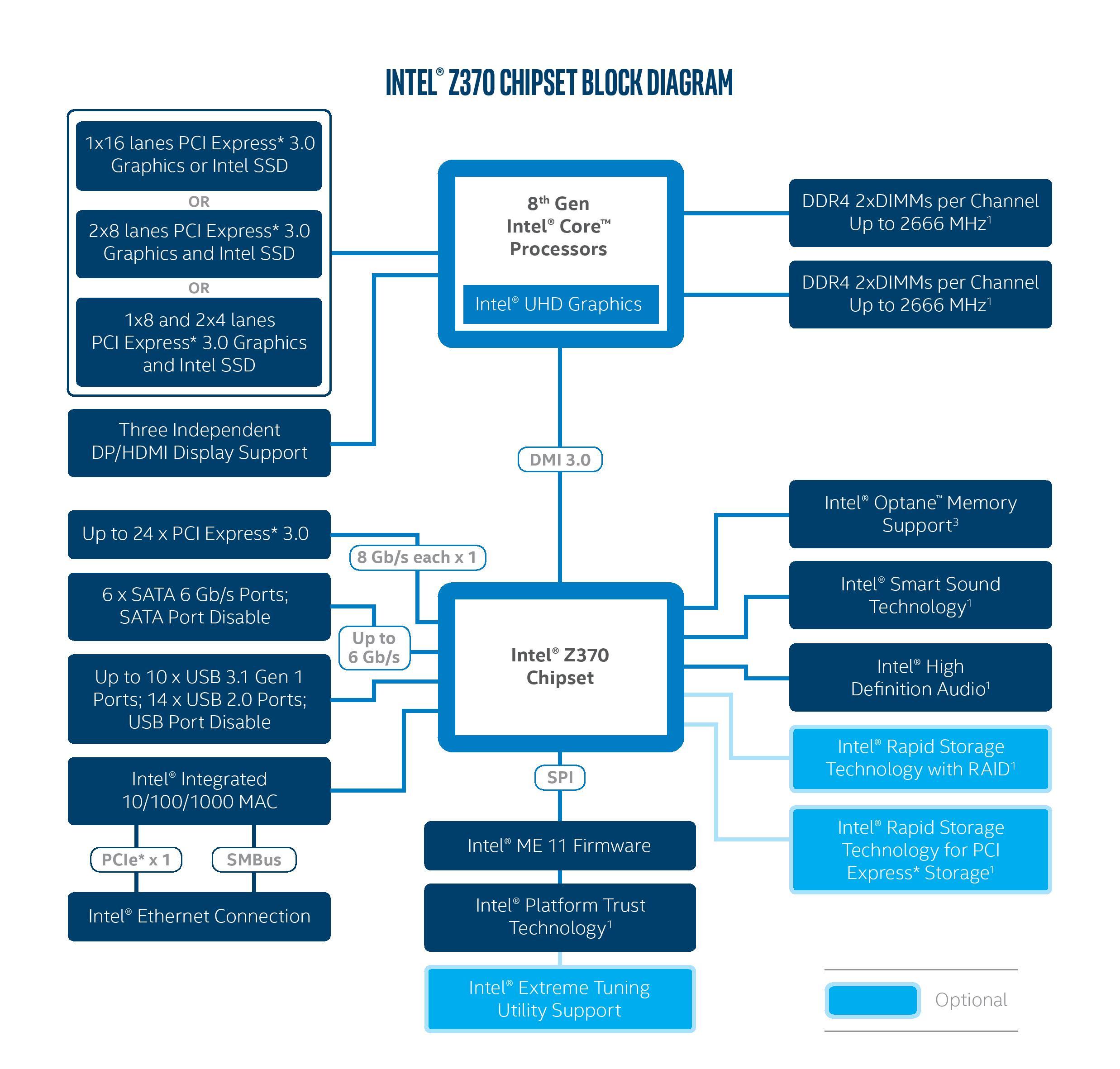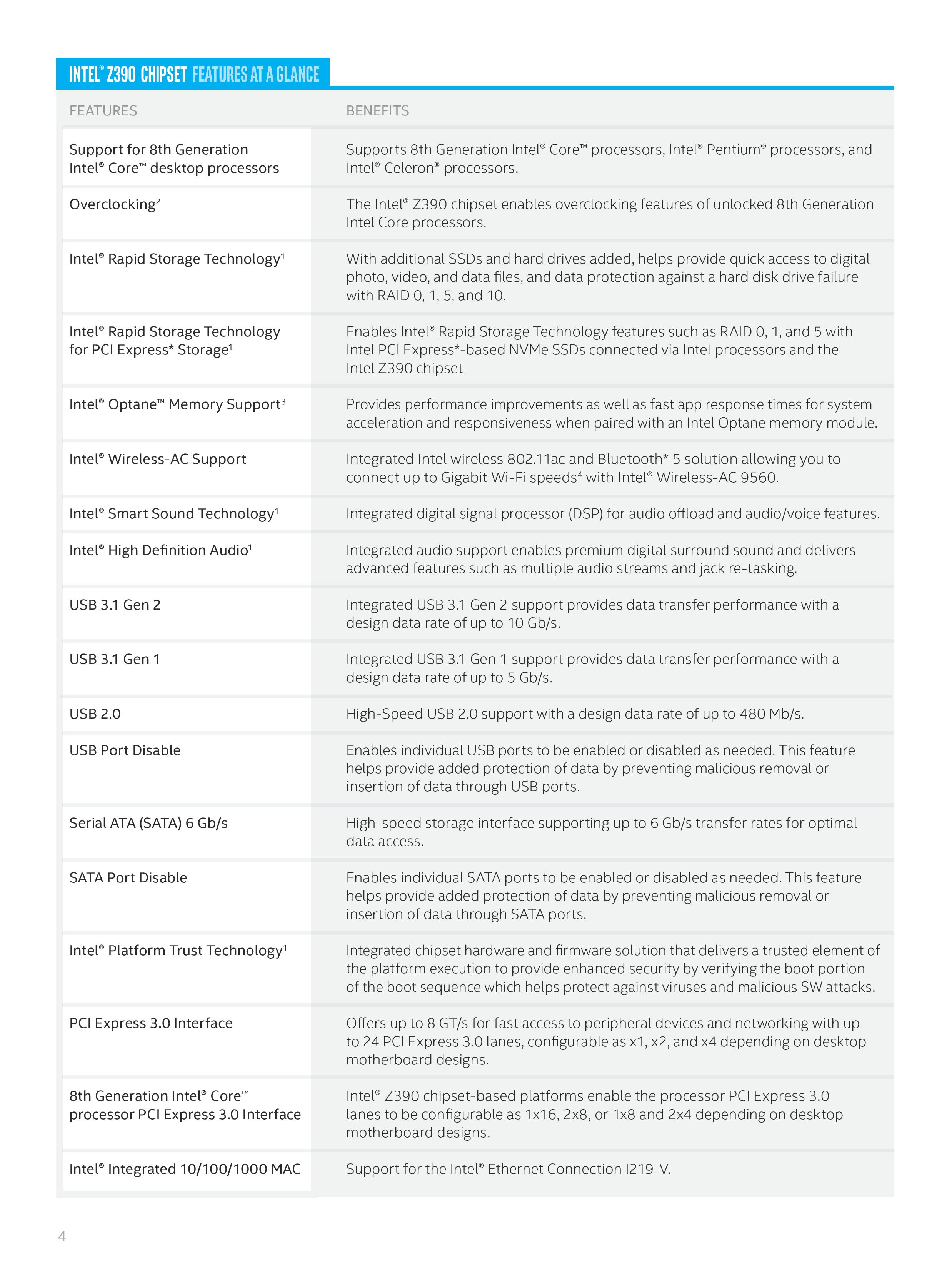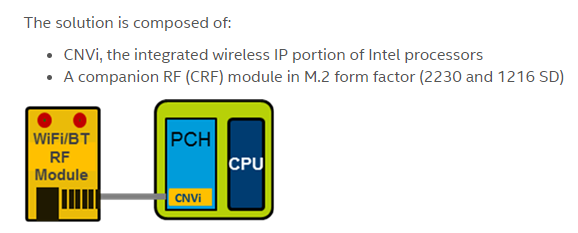Intel Releases Z390 Chipset Product Information: New Motherboards Inbound
by Ian Cutress on May 14, 2018 9:00 AM EST
In an unexpected disclosure of information, Intel’s Z390 Product Brief documentation went online today. No prior warning was given, and we were expecting something similar to perhaps pop up during Computex in a few weeks, but it would seem that Intel has pulled the plug during a Sunday (which makes me think this was an accidental posting, but I’m not complaining).
Z390 is the second generation of high-end chipset for Intel’s 300-series platform for Coffee Lake desktop processors. It builds on Z370 in two obvious areas: chipset support for up to six USB 3.1 (10 Gbps) ports, and introduces a built in wireless networking MAC for dual-band 802.11ac Wi-Fi use via Intel’s new integrated connectivity feature. This uses Intel’s 802.11ac Wave 2 configuration, suitable for up to 160 MHz wireless bands. These additions mirror what we saw when Intel launched the low-range and mid-range chipsets such as H370, B360, and H310, in early April.
| Intel 8th Gen Chipsets (PCH) | |||||||
| AnandTech | Z390 | Z370 | H370 | Q370 | B360 | H310 | |
| Launch | May '18 | Oct '17 | Apr '18 | Apr '18 | Apr '18 | Apr '18 | |
| Market | Consumer | Y | Y | Y | - | Y | Y |
| Corporate | - | - | Y | Y | Y | - | |
| ME Firmware | ? | 11 | 12 | 12 | 12 | 12 | |
| HSIO Lanes | 30 | 30 | 30 | 30 | 24 | 14 | |
| Total USB | 14 | 14 | 14 | 14 | 12 | 10 | |
| Max USB 3.1 G2 | 6 | - | 4 | 6 | 4 | 0 | |
| Max USB 3.1 G1 | 10 | 10 | 10 | 8 | 6 | 4 | |
| SATA 6 Gbps | 6 | 6 | 6 | 6 | 6 | 4 | |
| PCH PCIe 3.0 Lanes | 24 | 24 | 20 | 24 | 12 | - | |
| PCH PCIe 2.0 Lanes | - | - | - | - | - | 6 | |
| Max RST PCIe Storage | 3 | 3 | 2 | 3 | 1 | 0 | |
| Supports Optane | Y | Y | Y | Y | Y | N | |
| Integrated 802.11ac | Y | N | Y | Y | Y | Y | |
| Intel Smart Sound | Y | Y | Y | Y | Y | N | |
| Intel vPro | N | N | N | Y | N | N | |
| TDP | ? | 6 W | 6 W | 6 W | 6 W | 6 W | |
Overall, this disclosure essentially paints a picture of how Coffee Lake CPUs were initially launched. It appears to be that the chipsets with USB 3.1 and integrated Wi-Fi were not expected to be ready when the CPUs were to be launched, and so Z370 came out as a Z270 refresh but for Coffee Lake only. Now that the chipset designs with USB 3.1 and Wi-Fi are ready, we are seeing Z390 as the true high-end chipset for Intel’s mainstream platform.
Comparing the Z370 and Z390 general block diagrams side by side showcases the two differences listed above: on the left are the new USB 3.1 ports and on the right is the integrated Wi-Fi MAC. As with other Z-series chipsets, these allow overclocking, and are also not vPro enabled (Q-series only).
Other standard features include RAID support, RSTe, Optane Memory support (as Boot and non-Boot drives), and HSIO lanes.
Z390 Updates
Taken from our 8th Gen Chipset Analysis
The first headline feature is the integrated 2T2R 802.11ac Wi-Fi support, allowing the latest Wave 2 (160 MHz) channel communications and giving speeds up to 1733 Mbps. Intel states that this is 12x faster than 1T1R 802.11n support provided by low cost solutions, and double the performance of most 2T2R options on the market. Despite Intel support however, not all motherboards that use a chipset that offers this feature will have it implemented: we canvassed some of the manufacturers and were told that the periphery around Wi-Fi support, such as manufacturing, trace layouts, the companion module, antenna, and potential regulatory support (given devices shipping with Wi-Fi) can add an additional $15 cost to the motherboard. While Z390 is the high end chipset, it will span a range of prices from the low $130 range all the way up, so some motherboards may not have this feature in order to save cost.
Intel’s Wi-Fi solution relies on its integrated connectivity feature, CNVi, enabled in Gemini Lake and now in the latest 8th Gen processors. This method pushes the large/expensive functional blocks from the Wi-Fi module (such as the logic, MAC, and memory) directly onto the chipset, leaving the PHY and antenna on the companion RF module (CRF). These connect together through the CNVio interface via a specialised M.2 slot. Intel’s own webpage on the feature states that it has three different CRFs possible, all under the ‘Jefferson Peak’ platform codename:
- The AC-9560 (the 2T2R module, the only vPro enabled CRF),
- The AC-9462 (a 1T1R module with FIPS9 support), and
- The AC-9461 (a low-end 1T1R module).
All three CRFs support Linux, Chrome OS, and Windows 10, but are only offered with a 1 year warranty.
The second headline feature is the support for USB 3.1 Gen 2 (10 Gbps) ports native to the chipset. This is using Intel’s own IP, and shows Intel reaching parity with the competition. Motherboard manufacturers will have to use HSIO lanes to enable USB 3.1 Gen 2 (10 Gbps) ports, with up to four being supported on H370/B360, and six being supported on Q370 and Z390. In order to implement a Type-C port, a re-driver is required, as with other Type-C implementations. It will be interesting to see the number of 10 Gbps ports that are put into play on the motherboards available.
Also on the plate for the chipsets are features like Modern Standby/Smart Connect, allowing for systems to update email and such while in a sleep state similar to some laptops. Intel was proud to state that this is the first time the feature has come to the desktop, whereas previously it was seen more as a laptop-focused feature. This is enabled through the chipset and the network connection, and while Intel only lists the 1T1R enabled CRFs as supporting this feature, the 2T2R does as well.
Intel also lists ‘ambient computing’ as being enabled by the chipset. This allows for wake-on-voice in a low powered mode, much like a smartphone or connected device that the user can call Cortana or Alexa while the system is in screen-off or Modern Standby.
I Just Purchased a Z370 Motherboard, What Should I Do?
The main differences depends on if you use USB 3.1 (10 Gbps) ports, or Wi-Fi. If those features are something already in use on the Z370 board in play, then the only difference is that the Z390 motherboard might* use slightly less power (less than a few watts) or that the Z390 version might* have been slightly cheaper. But if anything, you are not missing out on that much. If you do not use those features, then there is no real loss.
*might: postulated expectations that sound plausible. Until we get the hardware in to test, there is no way of knowing.
What Happens to the Z370 Motherboards?
I fully expect that motherboard manufacturers have manufactured plenty of Z370 models that Z390 will be earmarked mostly for the high-end and that both will be sold side-by-side. For example, ASUS has not launched a Maximus X Extreme yet, neither have ASRock launched an OC Formula on this platform, so it is likely that these will be on Z390 only. I would expect, stock permitting, that new designs down the like, such as future revisions to motherboard designs, will be using the newer Z390 chipsets where it makes sense to do so. However expect reviews of both Z370 and Z390 boards for the next few months at a minimum.
Where Are The Z390 Motherboards?
Computex is the first week of June. Given that Intel has made this disclosure now, it is likely that most motherboard manufacturers will push for the ability to show their designs on the show floor.
Source: Intel (via SH SOTN)



















34 Comments
View All Comments
JoeyJoJo123 - Monday, May 14, 2018 - link
There's no need.Even for the longest time PCI-e 2.0 to 3.0 performance differences were negligible, and they still mostly are. Same thing with 3.0 x8 lane vs 3.0 x16 lane. Even GPUs aren't so sophisticated that it completely saturates the port's capabilities.
Forcing PCI-e 4.0 adoption now would only result in higher costs to consumers, without seeing any inherent benefit. I'm all for technology progressing, but there's just not a strong necessity for 4.0 right now.
lioncat55 - Monday, May 14, 2018 - link
We are right at the point that PCIe 3.0 x8 is starting to bottle neck. PCIe 4.0 will be needed in one to two generations.SirPerro - Tuesday, May 15, 2018 - link
You just answered yourself here"since gaming rigs can last 4-8 years before the CPU/mobo are outdated and need replaced they need to get the faster connect deployed years before it's actually needed to avoid premature retirement"
Why do you think Intel, OEMs, Nvidia, AMD, or anyone in the industry would really want you to avoid premature retirement?
DanNeely - Monday, May 14, 2018 - link
*gaming* isn't bottlenecked yet on 3.0. But since gaming rigs can last 4-8 years before the CPU/mobo are outdated and need replaced they need to get the faster connect deployed years before it's actually needed to avoid premature retirement.The foot dragging from 3.0 to 4.0 at the standard setting stage had gotten to the point that proprietary interconnects like NVLink were gaining traction because it was becoming an issue for forms of compute that required rapid interaction with the host CPU (not just dump into the GPU and let it chug until it has a result to spit out). Trying to catch up there and defend their territory is a big part of why the 5.0 spec came out only a year or two after the 4.0 one.
High end SSDs are also getting rather close to maxing out PCIe3 x4 connection, which is a feature at the enthusiast level.
DMI effectively being a single 3.0 x4 lane is becoming a potential bottleneck with is plausible to hang multiple devices capable of using most of an x4 slot of bandwidth by themselves.
The real reason we haven't seen 4.0 yet is that there hasn't been time to incorporate it into new CPUs yet. Ice Lake or Ryzen 3 next year might have the first 4.0 CPU lanes out a year from now. Even then chipset lanes are likely to lag a year or two behind based on Intel's past history; and possibly even longer for AMD. (They're still only 2.0 on the chipset, although with 24 on the CPU that's less critical a concern since they probably won't be running SSDs or a GPU off them.)
I suspect having to wait for the next major refresh is also why we don't have TB3 on this chipset yet. To avoid bottlenecking DMI it either needs to be on the CPU itself, or DMI needs to be based on something faster than an 3.0 x4 link.
willis936 - Monday, May 14, 2018 - link
High end SSDs aren't close to maxing out PCIe3 x4. They already are. Who wants to dish out big bucks on a ten year machine when the storage bottleneck will be the interconnect from day one? Tech industries have operated for the past few decades to keep interconnects ahead of demand because it stinks when the bottleneck is not the most complicated and expensive component (interconnects are cheap compared to bleeding edge SSDs).SirPerro - Tuesday, May 15, 2018 - link
You just answered yourself here"since gaming rigs can last 4-8 years before the CPU/mobo are outdated and need replaced they need to get the faster connect deployed years before it's actually needed to avoid premature retirement"
Why do you think Intel, OEMs, Nvidia, AMD, or anyone in the industry would really want you to avoid premature retirement?
boe - Thursday, May 17, 2018 - link
Sorry Joey but that is incorrect. The difference isn't negligible and will be more significant with the soon to be released 1180 card. In addition to that we need more PCIe lanes so 8x add on cards can communicate with the chipset at full speed instead of the 4x chipset bottleneck.beginner99 - Monday, May 14, 2018 - link
I woudl rather like to see 8xPCIe 3 from CPU to chipset. DMI 3.0 is a joke at this point.Cygni - Monday, May 14, 2018 - link
2020, same time as DDR5.wr3zzz - Monday, May 14, 2018 - link
What is going on with Intel's marketing? We have gone from 3 classes of CPU with 2-3 classes of chipset to now 4 classes of CPU with 6! classes of chipsets. The mess alone is pushing me over to Team Red for next build.